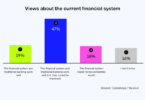Funds network Calastone has a vision of tokenizing the entire asset management sector, not just the funds but the underlying assets. In the future, in place of standardized mutual funds, every investor might have a bespoke portfolio of tokenized assets based on their risk-reward preferences.
The Calastone funds network connects 2,500 asset managers, fund distributors and their services providers and processes £200 billion ($276 billion) every month. Despite its scale, it’s still a tiny part of the fund sector globally valued at more than $50 trillion. Calastone’s core order routing has used blockchain technology since May 2019, but that’s just the start.
CTO Adam Belding spoke to Ledger Insights about the future potential to “reconnect asset managers with retail customers more directly and create something that goes even beyond a mutual fund.”
He continued, “So it’s almost like a scaled model portfolio with millions of different variations that directly invests in any of the underlying assets that a fund wants to invest in.”
That involves tokenizing cash, equities, bonds, derivatives and other assets, and is the reason why Calastone is a member of tokenization standards body the Interwork Alliance.
We noted the model portfolio has some similarity with eToro’s social investing idea where consumers can choose to clone another investor’s portfolio, usually an amateur.
One of the benefits of tokenization is the ability to fractionalize the underlying stocks, bonds or other derivatives, much like mutual funds fractionalize portfolios. It also brings transparency.
“They (investors) can very clearly see exactly what they’re invested in, how they’re performing. The ESG angle is covered really nicely because you can see directly that you haven’t been put into an oil company or a tobacco company. So we see that as the endpoint that we’re trying to get to by enabling the industry to take these steps,” said Belding.
But that’s not going to happen overnight. Let’s look at where Calastone is today and then the potential path to that future.
How Calastone uses blockchain
At the heart of the Calastone solution is order routing. If an investor buys some funds through a bank, the order goes via Calastone to the fund manager or their transfer agent. This functionality has leveraged blockchain since May 2019 at scale, and Calastone refers to it as a Distributed Market Infrastructure (DMI).
More recently, Calastone has introduced DMI Fund Services that goes significantly beyond order routing towards fund administration, with the first stage targeting transfer agents. One might expect an automation platform like Calastone to disintermediate transfer agents, but Belding said it’s “enabling transfer agents rather than looking to eliminate them”.
With DMI Fund Services, the Calastone platform doesn’t just store the transaction’s golden record but also the asset manager’s entire fund register. Apart from making it simpler to execute corporate actions such as dividends, the ‘single source of truth’ should eliminate reconciliations.
A key point with any funds network is new integrations with asset managers or service providers are done by the network operator, rather than every transfer agent or distributor needing to implement them.
The path to the big blockchain vision
On the topic of integration and interoperability of blockchain solutions, Belding is not so optimistic.
“This amazing vision of this global blockchain, where everything runs and there’s real DVP (delivery versus payment) and all the cash is there and all the assets are there. That’s pretty much blue sky,” he said.
He believes the internet of blockchains is a distant future because there are numerous different systems being developed, which likely won’t be natively interoperable for a long time. “You just really end up with the same ecosystem that already exists now that you have to orchestrate and bring together potentially in a slightly new way because they’re all blockchains. But it’s still a massive challenge,” said Belding.
So how does this tally with Calastone’s big vision? The slightly self-serving answer is for the funds industry to use Calastone’s one-stop shop solution. It’s a shared market infrastructure for the funds industry, but instead of being owned by the sector, the network is owned by Carlyle’s Calastone.
In reality, such a vision might save the entire sector a ton of money, even if it results in monopoly profits. More likely, there will be a small handful of players given there are others eyeing a similar idea, including FundsDLT and Allfunds. However, Calastone has a head start.
Blockchain technology and its challenges
One of the biggest issues with enterprise blockchain is adoption friction. Belding highlighted that this is a non-issue for Calastone because it provides so many ways to integrate, ranging from APIs and SWIFT messages to spreadsheet files.
A major challenge has been the fact that blockchains are not databases and businesses need relational databases to query data in the usual way. So the transactions from Calastone’s private permissioned version of Ethereum are synchronized with a database.
When asked how many third parties host blockchain nodes, the lack of response leads us to conclude that Calastone’s blockchain network is currently pretty centralized.
However, Belding mentioned some changes in its blockchain technology are being driven by discussions with partners who plan to host nodes.
To date, Calastone used a private permissioned version of Ethereum using Proof of Authority, but it’s close to completing an update to a different Ethereum version, Hyperledger Besu, which Belding described as being “purpose built for an enterprise financial services environment.”
While the current version uses permissions for various parties to access data, the attraction of Besu was that it is “natively capable of supporting proper privacy out of the box,” said Belding.
We also noted that Besu has been designed by its creators and ConsenSys backers as a path for enterprises to public blockchain.
Belding acknowledged this and noted that “if new distribution channels or other capabilities can be built there (public Ethereum), we’re very well positioned to take advantage of that.”






